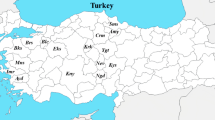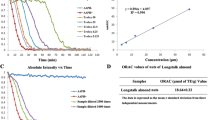Abstract
Seeds and plants of Amaranthus have been a source of food for many cultures in the world. Some species can be found as weeds or growing wild under severe climatic and soil conditions, but their potential as food sources has not been studied. The objective of this work was to study the nutritional quality of four wild species ofAmaranthus,A. retroflexus (AR),A. viridis (A V),A. palmeri (AP) andA. blitoides (AB) as potential sources of vegetable greens. Histochemical studies showed higher levels of starch in leaves of AR and AB, moderate amounts of tannins in all leaves, high protein concentration in stems and leaves, and moderate amounts of alkaloids in all tissues of AV and AB. Antinutritional factors (nitrates, oxalates, cyanogenic glycosides, tannins and phytates) were quantified in plants at the preflowering stage, but only nitrates were found at levels (0.34-2% dw) above those generally considered as safe, but at similar levels found in spinach. No cyanogenic glycosides were detected in any species. Bromatologic analysis of whole or different plant parts at preflowering and maturity (mature seeds) showed that mature whole plants or individual sections can be recommended as animal feed since they contain high levels of protein (20.6-24.7% whole plant, 25.3-32.9% leaves) and soluble carbohydrate (>40%).Amaranthus plants could be best consumed as vegetables at the preflowering stage. At this stage, the highest protein concentrations were found in leaves (22.8-27.8%), while the remaining chemical composition was very similar to that found in other food vegetables. The four species showed similar chemical compositions, and had no detrimental chemicals which would deter their use as vegetable foods. Organoleptic taste preference studies would best indicate the stage at which the plant should be harvested for human consumption.
Abstract
Las semillas y plantas deAmaranthus (alegría) han sido fuente de alimento para muchas culturas del mundo. Algunas especies pueden encontrarse como maleza o creciendo en forma silvestre bajo condiciones climáticas o de suelo muy severas, pero su potencial como alimento no ha sido estudiado. El objetivo de este trabajo fue el de estudiar el potencial nutritional como hortaliza de cuatro especies silvestres deAmaranthus, A. retroflexus (AR),A. viridis (A V),A. palmeri yA. blitoides (AB). Los estudios histoquímicos demostraron altos niveles de almidón en hojas de AR y AB, cantidades moderadas de taninos en todas las hojas, una alta concentratión de proteína en tallos y hojas, y un contenido moderado de alcaloides en todos los tejidos de AV y AB. Se cuantificaron los factores antinutricionales (nitratos, oxalatos, glucósidos cianogénicos, taninos y fitatos) en plantas en la etapa de prefloración, y solamente los nitratos se encontraron en nivelesarriba de los considerados seguros (0.34-2% p.s.), pero a niveles similares a los de la espinaca. En ninguna especie se detectaron glucósidos cianogénicos. El análisis bromatológico mostró que plantas enteras y sus secciones en las etapas de prefloración y madura pueden ser recomendadas como alimento animal ya que contienen altos niveles de proteína (20.6-24.7% planta entera, 25.3-32.9% hojas) y carbohidratos solubles (>40%). Las plantas deAmaranthus pueden se consumidas como hortalizas en la etapa de prefloración. En esta etapa se encontraron los niveles máximos de proteína en las hojas (22.8-27.8%), mientras que la composición bromatológica restante fue muy similar a la encontrada en otras hortalizas. Las cuatro especies mostraron una compositión química muy similar y mostraron la ausencia de compuestos químicos dañinos que impediría su uso como hortaliza. Estudios de preferencia organoléptica serían los mejores indicadores de la mejor etapa de cultivo de estas especies para consumo humano.
Similar content being viewed by others
Literature Cited
A.O.A.C. 1980. Official Methods of Analysis. Association of Official Analytical Chemists. Washington, D.C.
BOSTID. 1987. El Amaranto, Perspectivas Modernas para un Cultivo Olvidado. Informe de la Comisión Especial del Comité Asesor sobre Innovación Tecnológica para el Desarrollo International. Editorial Villacaña S.A.
Campbell, T. A., and J. A. Abbott. 1982. Field evaluation of vegetable amaranth (Amaranthus). American Society for Horticultural Science 17:407–409.
Carlsson, R. 1979. Quantity and quality ofAmaranthus grain from plants in temperate, cold and hot subtropical climates. A review.In “Proceedings of the Second Amaranth Conference,” Rodale Research Center, Kutzatown, PA, Rodale Press, Emmaus, PA.
Davis, K. R. 1981. Proximate Composition, Phytic Acid, and Total Phosphorus of Selected Breakfast Cereals. Cereal Chemistry 58:347–350.
de Troiani, R. M. 1989. Contenido de nitratos y proteína en plántulas deAmaranthus cruentus L. cv. Don Guiem.En AMARANTOS Novedades e Informaciones. Facultad de Agronomía de la Universidad Nacional de La Pampa, República Argentina. No. 2:3–4.
Gómez, R. G., M. H. Bertoni, and G. Covas. 1986. Composición química general y contenido de oxalatos y nitratos totales y remanentes despues de cocción del follaje en especies americanas de amarantos (Amaranthus spp.). Anales de la. Asociación Química Argentina 74:333–338.
Irving, D. W., A. A. Betschart, and R. M. Saunders. 1981. Morphological studies onAmarantuhus cruentus. Journal of Food Science 46:1170–1174.
Johansen, J. A. 1941. Plant Microtechnique. McGraw-Hill, New York.
Maiti, R. K., P. Wesche-Ebeling, and F. Sosa-Alvarado. 1991a. Especies silvestres deAmaranthus de Nuevo León, México: I. Aspectos Ecológicos y Botánicos. Universidad y Ciencia (UJAT-México) 8(15):61–67.
—,and —. 1991b. Especies silvestres de Amaranthus de Nuevo León, México: II. Patrones de crecimiento. Universidad y Ciencia (UJAT-México) 8(15):69–76.
-, and -. 1993. Especies silvestres de Amaranthus de Nuevo León, México: III. Distributión, description y morfoanatomía. Universidad y Ciencia (UJAT-México) 10(19): (in press).
Martin, R.W., and R. M. Ruberte. 1979. Edible leaves of the tropics. U.S. Dept. of Agriculture, Mayagüez Institute of Tropical Agriculture, Mayagüez, Puerto Rico.
Masefield, G. B., and M. Wallis. 1980. Guía de las Plantas Comestibles. Editorial Omega. Mexico.
Morales, J., D. Granados, and J. Martinez. 1984. Respuesta del amaranto (Amaranthus hypocondriacus L.) a la fertilización quimica y orgánica en condiciones de temporal en dos áreas del Estado de Tlaxcala. Memorias del Primer Seminario del Amaranto. Vol. I, Colegio de Posgraduados, Chapingo, Mexico.
N.A.S. 1975. Under-exploited Tropical Plants with Promising Economic Value. National Academy of Sciences. Washington, DC.
Oh, H. I., J. E. Hoff, G. S. Armstrong, and L. A. Haff. 1980. Hydrophobic interactions in tannin-protein complexes. Journal of Agricultural and Food Chemistry 28:394–398.
Oke, O. L. 1983. Amaranth.In H. T. Chan Jr., ed., Handbook of tropical foods. Marcel Dekker, Inc., New York.
Oliveira, J. S., and M. F. de Carvalho. 1975. Nutritional value of some edible leaves used in Mozambique. Economic Botany 29:255–263.
Orr, M. L., and B. K. Watt. 1957. Amino acid contents of foods. USDA Home Economics Research Report No. 4, Washington, D.C.
Saini, H. S., and N. Wratten. 1987. Quantitative determination of total glucosinolates in rapeseed and meal digests. Journal of the Association of Official Analytical Chemists 70:141.
Santín, H. C., M. Lazcaño, and L. J. Morales. 1986. Pasado, Presente y Futuro del Amaranto. Instituto Nacional de la Nutrición Salvador Zubiran, Cuadernos de Nutrición No. 1.
Sauer, J. 1977. The grain amaranth and their relatives: A revised taxonomic and geographic survey. Pages 13–24in Amaranth Roundup. Rodale Press Inc., Emmaus, PA.
Saunders, R. M., and R. Becker. 1984.Amaranthus: a potential food and feed resource.In Y. Pomeranz, ed., Advances in cereal science and technology. Vol. VI. American Association of Cereal Chemists, St. Paul, Minnesota.
Surikno, A.I., D. Suherman, and B. Tangendjaja. 1987. A screening method for total oxalate determination in plant material by gas cromatography. Journal of the Science of Food and Agriculture 39:233–238.
Synge, R. L. M. 1975. Interactions of polyphenols with proteins in plants and plant products. Qualitas Plantarumu 24:337–350.
Teutonico, R. A., and D. Knorr. 1985a. Amaranth: composition, properties, and applications of a rediscovered food crop. Food Technology 39(4):49–60.
—. 1985b. Nondestructive method for determination of water-soluble oxalate in culturedAmaranthus tricolor cells. Journal of Agricultural Food Chemistry 33:60–62.
Torres-Cepeda, T. E. 1990. Estudio comparativo de las características anatómicas, morfológicas y algunos aspectos bioquímicos y nutricionales de variedades de granos de sorgo (Sorghum bicolor (L.) Moench) utilizado para alimentación de ganado bovino de engorda en el noreste del país. Tesis de Maestría en Ciencias con Especialidad en Botánica. Facultad de Ciencias Biológicas, U.A.N.L. Monterrey, N.L., México.
U.S.D.A. 1981. Investigación de Suelos: Métodos de Laboratorio y Procedimientos para Recoger Muestras. Departamento de Agricultura, Servicio de Conservatión de Suelos, E.U.A. Editorial Trillas, S.A., México, D.F.
Wesche-Ebeling, P., D. I. González, G. García, and R. K. Maiti. 1993. Cuantificación de compuestos antinutricionales en cuatro especies silvestres deAmaranthus en Nuevo León. Turrialba 42(4):487–491.
Wills, R. B. H., A. W. K. Wong, F. M. Scriven, and H. Greenfield. 1984. Nutrient composition of Chinese vegetables. Journal of Agricultural and Food Chemistry 32:413.
Author information
Authors and Affiliations
Rights and permissions
About this article
Cite this article
Wesche-Ebeling, P., Maiti, R., García-Díaz, G. et al. Contributions to the botany and nutritional value of some wild amaranthus species (Amaranthaceae) of Nuevo leon, Mexico. Econ Bot 49, 423–430 (1995). https://doi.org/10.1007/BF02863094
Received:
Accepted:
Issue Date:
DOI: https://doi.org/10.1007/BF02863094




